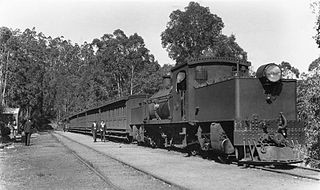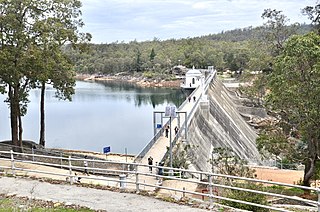Related Research Articles

Eucalyptus marginata, commonly known as jarrah, djarraly in Noongar language and historically as Swan River mahogany, is a plant in the myrtle family, Myrtaceae and is endemic to the south-west of Western Australia. It is a tree with rough, fibrous bark, leaves with a distinct midvein, white flowers and relatively large, more or less spherical fruit. Its hard, dense timber is insect resistant although the tree is susceptible to dieback. The timber has been utilised for cabinet-making, flooring and railway sleepers.

John Forrest National Park is a national park in the Darling Scarp, 24 km (15 mi) east of Perth, Western Australia. Proclaimed as a national park in November 1900, it was the first national park in Western Australia.

The Darling Scarp, also referred to as the Darling Range or Darling Ranges, is a low escarpment running north–south to the east of the Swan Coastal Plain and Perth, Western Australia. The escarpment extends generally north of Bindoon, to the south of Pemberton. The adjacent Darling Plateau goes easterly to include Mount Bakewell near York and Mount Saddleback near Boddington. It was named after the Governor of New South Wales, Lieutenant-General Ralph Darling.

The Upper Darling Range railway was a branch railway from Midland Junction, Western Australia, that rose up the southern side of the Helena Valley and on to the Darling Scarp via the Kalamunda Zig Zag. At the time of construction it was the only section of railway in Western Australia to have had a zig zag formation.

The Mundaring Weir branch railway was constructed from Mundaring, Western Australia to the site of the Mundaring Weir, and opened on 1 June 1898.

Hamelin Bay is a bay and a locality on the southwest coast of Western Australia between Cape Leeuwin and Cape Naturaliste. It is named after French explorer Jacques Félix Emmanuel Hamelin, who sailed through the area in about 1801. It is south of Cape Freycinet.

Mundaring Weir is a concrete gravity dam located 39 kilometres (24 mi) from Perth, Western Australia in the Darling Scarp. The dam and reservoir form the boundary between the suburbs of Reservoir and Sawyers Valley. The dam impounds the Helena River.

Jarrahdale is a small historic town located 45 km south-east of Perth, Western Australia in the Darling Range. The name is derived from its situation in a jarrah forest. Established in the late 1800s as the state's first major timber milling operation, it played a key role in the development of Western Australia through the exportation of jarrah around the world. At the 2016 census, Jarrahdale had a population of 1,192. Since 2001, the historic precinct has been managed by the state's National Trust organisation alongside private residential and tourism-oriented developments.
Maurice Coleman Davies was an Australian timber merchant and pastoralist. Born in London, he emigrated to Tasmania with his family as a child, and later moved to Blackwood in the Victorian goldfields, then to Melbourne and Adelaide. He then relocated to Western Australia, where he created the M. C. Davies Company, later the M. C. Davies Karri and Jarrah Timber Company, a timber empire that employed hundreds of men, laid over a hundred kilometres of private railway, including the Flinders Bay branch railway, and even built its own private ports for exporting of timber. He also formed the Kimberley Pastoral Company and was its managing director.
Canning Mills is a suburb of Perth, Western Australia in the City of Kalamunda. The suburb was gazetted on 22 September 1972. Its name relates to the Canning River.

The Goldfields Water Supply Scheme is a pipeline and dam project that delivers potable water from Mundaring Weir in Perth to communities in Western Australia's Eastern Goldfields, particularly Coolgardie and Kalgoorlie. The project was commissioned in 1896 and completed in 1903.

The network of railway lines in Western Australia associated with the timber and firewood industries is as old as the mainline railway system of the former Western Australian Government Railways system.

Statham's Quarry is the site of a quarry on the Darling Scarp on the southern side of the entrance of the Helena River valley on to the Swan Coastal Plain in Perth, Western Australia. It is located in Gooseberry Hill and is within the bounds of the Gooseberry Hill National Park.
Millars' Karri and Jarrah Company (1902) Limited, commonly known as Millars, was a Western Australian focused timber and timber railway company.
State Batteries in Western Australia were government owned and run ore-crushing facilities for the gold mining industry. Western Australia was the only Australian state to provide batteries to assist gold prospectors and small mines. They existed in almost all of the mineral fields of Western Australia.
The Nannup branch railway, also known as the Wonnerup to Nannup railway, was a branch line of the Western Australian Government Railways (WAGR) between Wonnerup and Nannup.

The Ballaarat tramline, also known as the Lockville–Yoganup railway, was the first railway in Western Australia, constructed in 1871 by the Western Australian Timber Company. The railway was used to transport timber from forests in the South West to the company's jetty at Lockville using the Ballaarat steam engine.

The Fremantle Trades Hall is a two-storey former trade union hall in Fremantle that was built during the gold boom period and completed in 1904. The building is located at the corner of Pakenham and Collie Streets in the west end conservation area of the city.

The Chidlow Tavern was opened in 1884 in Chidlow a hills suburb of Perth, Western Australia. It was originally called The Oxford Inn before assuming its current name in 1973.
References
- ↑ "Canning Jarrah Timber Co". The Inquirer and Commercial News . Vol. LVIII, no. 3, 171. Western Australia. 14 January 1898. p. 9. Retrieved 23 December 2018– via National Library of Australia.
- ↑ "Canning Jarrah Timber Company's Railway". Western Mail . Vol. XV, no. 745. Western Australia. 7 April 1900. p. 9. Retrieved 23 December 2018– via National Library of Australia.
- ↑ Shaw, W (1900), Canning Jarrah Timber Company Ltd 1891-1903 , retrieved 23 December 2018